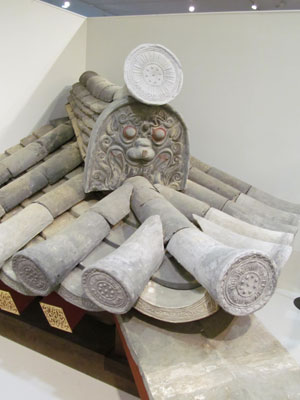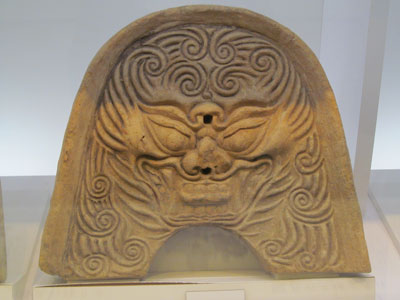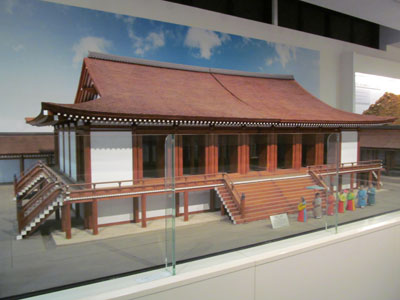Heijō: Japan’s eighth-century capital
This item appears on page 53 of the August 2016 issue.
The eighth century in Japan was a peripatetic century as far as capitals go. Within the space of one hundred years, AD 694 to 794, Japan’s capital made four major moves. After 16 years in Fujiwara (694 to 710), the capital moved to Nara in 710, then to Nagaoka in 784 and, finally, to Kyoto in 794, where it remained for almost 1,100 years. In 1868, Tokyo replaced Kyoto as Japan’s capital.
As if all these major moves weren’t enough, there were also minor shiftings of the capital three times in the five years between 740 and 745.
Nara, then called Heijo¯-kyo¯, was the capital during most of the eighth century. Located 300 miles southwest of Tokyo, Heijō-kyō, or Heijō, was founded in 710 by Empress Genmei. She was one of only eight women to rule in her own right over the course of 27 centuries of emperors in Japan.
Ancient Heijō
Heijō was a cosmopolitan capital, with traders and merchants from all parts of Southeast Asia and India doing business in the city.
Modeled on the Chinese Tang capital of Chang’an (present-day Xi’an), Heijō measured 2.7 miles east to west and 3.1 miles north to south. In this large rectangular space, streets were arranged in a grid pattern similar to that in Chang’an. Occupying the north-central portion of the city was the Imperial Palace complex, packed with administrative offices, ceremonial structures and the emperor’s residence, all enclosed within walls punctuated with gates.
Heijō today lies within the bounds of modern-day Nara, so the site was never entirely forgotten even after Kyoto became Japan’s capital. The site of the ancient capital simply reverted to farmland for 11 centuries until excavations commenced in the mid-20th century.
When these excavations began, much was discovered beneath the fields, although nothing remained of the eighth-century buildings that once occupied the site. The sole exception was one administrative building that had been moved two miles away to become part of a temple, To¯sho¯dai-ji, which can be visited.
Monumental gate
In 1998, Suzakumon, the main gate to the imperial compound, was reconstructed. It stands at the south end of the complex and was where foreign dignitaries entered before being led to the Daigokuden, the Imperial Audience Hall.
The immense, 2-story gateway, now reconstructed in Japanese cypress wood and earthquake-proof concrete, would have served as an impressive introduction to the Imperial Audience Hall, which stood at the far-north end of the imperial complex.
Also reconstructed (2010) of Japanese cypress, with vermilion-painted pillars and a gabled roof, the 2-story Imperial Audience Hall was within a compound linked by corridors. In the audience hall, foreign guests were received by the emperor, whose throne stood inside.
The foundations of a later audience hall are visible nearby. This later hall was constructed in the mid-eighth century after the 5-year migration of the capital to Kuni, Shigaraki and Naniwa.
Royal residence
The Dairi, the Imperial Residence, stood east of the Imperial Audience Hall. This is where the emperor lived, worked on everyday government affairs and received guests. This building has not been reconstructed. Pruned Japanese holly trees imaginatively indicate where the palace’s pillars once stood.
There’s also a lovely reconstructed garden with a pond in the southeast corner of the palace complex not far from the Imperial Residence.
Some of the thousands of artifacts found during excavations are assembled in the Palace Site Museum west of the Imperial Audience Hall. In another museum, the Excavation Site Exhibition Hall, east of the Imperial Residence, a foundation of an eighth-century building is on display showing where the immense pillars supporting the building once stood.
There are also scale models of some of the other palace buildings that occupied the Imperial Palace site.
Temples and shrines
Many of the temples and shrines that once stood close to the Imperial Palace remained even after the capital moved in 784. They still stand and are now considered “must sees” by visitors to Nara.
They include To¯dai-ji, built in the mid-eighth century and housing one of Japan’s largest bronze Buddha statues; Kasuga-taisha, the ethereally beautiful Shinto shrine built in 768, and Ko¯fuku-ji, moved to Heijō in 710 from the earlier capital of Fujiwara.
Earlier burial mounds
Nearby are archaeological sites from a much earlier era. Between AD 250 and 550, massive earth mounds were erected over stone burial chambers. The name given to the mounds, kofun, is also the name of the era during which thousands of the mounds were constructed.
Some of the mounds have a distinctive keyhole shape and are thought to be imperial tombs. One of the kofun — a very large mound surrounded by a moat — is located a few minutes’ cab ride from Heijō. The kofun can be circled by cab in five minutes. In the vicinity around Heijo¯, there are other kofun that are obvious on local maps.
Heijō has been on the UNESCO World Heritage List since 1998 along with seven other sites in Nara.
Open from 9 to 4 every day except Monday, Heijō is closed from Dec. 29 to Jan. 3. Admission is free. Heijō is located a 20-minute bus ride from the JR Nara railway station or a 15-minute bus trip from the Kintetsu Nara railway station. It was a 15-minute taxi ride from the Nara Hotel, where my husband and I stayed during our three nights in Nara in 2015.
If you go…
We spent the month of November 2015 in Kyoto. Although Nara is an easy day trip from Kyoto — only a 35-minute train ride on Japan Rail or the Kintetsu rail line — we decided to spend three nights in Nara, savoring this wonderful old city with its abundance of temples, shrines and gardens, not to mention the abundance of tame deer that call Nara home and freely wander its streets looking for treats from visitors.
We stayed at the venerable Nara Hotel (1096 Takabatake-cho, Nara 630-8301, Japan; phone +81 742 26 3300, fax 742 23 5252, www.narahotel.co.jp/en/index.html), built in 1909, which offers both modern rooms and old-fashioned traditional rooms that resemble a Japanese version of the fictional Yorkshire country estate of Downton Abbey. Go for the old-fashioned rooms with high ceilings, decorative fireplaces and large, tiled bathrooms.
During the high-season months of March, April, October and November, prices for modern and traditional rooms range from ¥28,000 to ¥75,000 (near $269 to $720). Rates are lower in the other eight months of the year.
November is the prime fall foliage month — another major reason to spend a few nights in Nara.




